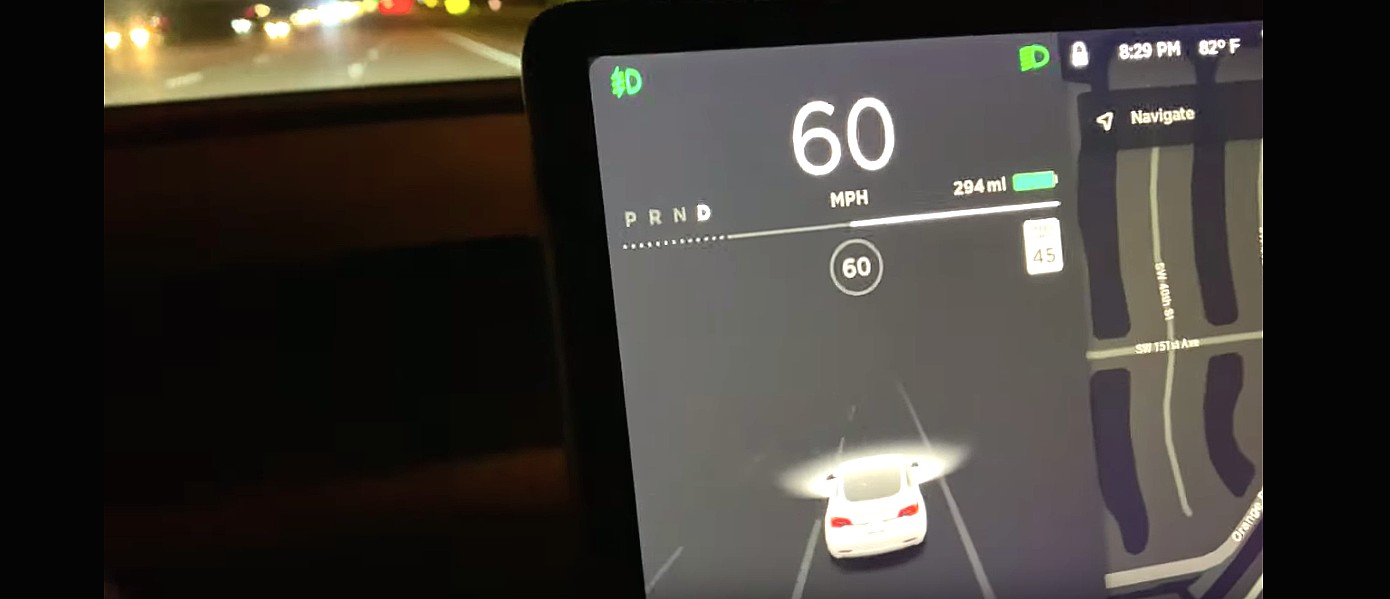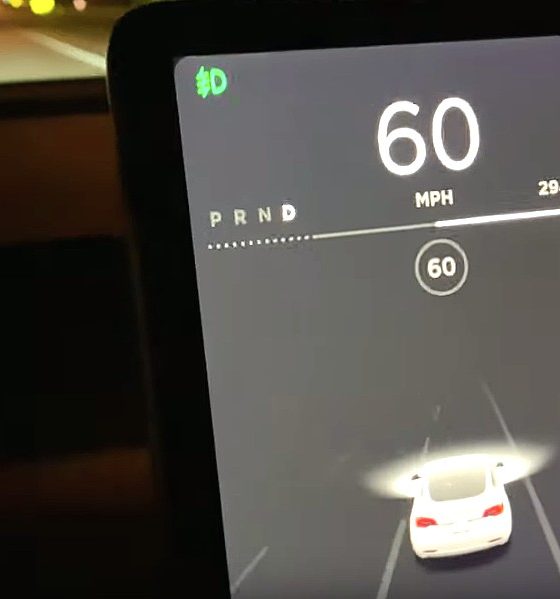The Tesla Model 3 Performance variant broke the three-second 0-60 MPH barrier after receiving a 5% performance update.
Popular Tesla YouTuber Brooks Weisblat of DragTimes shared data from numerous acceleration runs he performed in a Model 3, capturing before and after the 5% power update.
When he first received his car from Tesla, Weisblat benchmarked the vehicle’s performance in four separate 0-60 MPH runs, noting the fastest time as 3.050 seconds and quicker than Tesla’s advertised 0-60 MPH time of 3.2 seconds. After the update, Weisblat performed four more runs to test acceleration and was able to break the 0-60 MPH three-second barrier by recording a time of 2.998 seconds, giving the vehicle a rough theoretical horsepower increase of 23.7%.
Weisblat also tested his Model 3 Performance in a quarter-mile assessment. His vehicle’s pre-update time was 11.637 seconds, with a top speed of 115.485 MPH, but this time was beaten by the 5% power increase, capturing an 11.486 second time and a top speed of 117.495. “That is a pretty significant top-end increase from 115 to 117,” Weisblat added. “Overall…I think there definitely is a noticeable increase in power. I can’t say driving the car, you actually notice a huge difference, but the numbers right here actually show a little bit of a difference.” He believes if owners utilized lighter wheels or other performance parts that hold less weight, times could be reduced even further, perhaps into the 11.3 second mark for the quarter-mile.
CEO Elon Musk and VP of Technology Drew Baglino first hinted at the over-the-air power update for Model S, Model X, and Model 3 vehicles during the company’s Q3 earnings call in October. “We’re also expecting there is going to be an over-the-air improvement, that will improve the power of the Model S, X, and 3. By the way, it’s coming in a few weeks. It should be on the order of 5% power improvement due to improved firmware,” VP of Technology Drew Baglino said. “We are continuing to learn how to optimize motor control in our products. But yes, a 5% improvement for all Model 3 customers, and 3% for S and X,” The update was not only geared toward power improvements, however, as Tesla also announced there would be positive changes in Supercharging.
CEO Elon Musk was sure to add his two cents regarding the power and convenience of the company’s utilization of Over-the-Air updates to improve its products. “I don’t think there has ever been a situation in history where you buy a car and it gets way better over time, through software,” Musk said. Updates have provided power improvements like the one tested by Brooks Weisblat. However, Tesla has been able to add numerous entertainment options through the updates as well, making the Tesla ownership experience new and exciting.
Watch DragTimes results of the Model 3 Performance before and after the 5% power update below.

News
Tesla FSD fleet is nearing 7 billion total miles, including 2.5 billion city miles
As can be seen on Tesla’s official FSD webpage, vehicles equipped with the system have now navigated over 6.99 billion miles.

Tesla’s Full Self-Driving (Supervised) fleet is closing in on almost 7 billion total miles driven, as per data posted by the company on its official FSD webpage.
These figures hint at the massive scale of data fueling Tesla’s rapid FSD improvements, which have been quite notable as of late.
FSD mileage milestones
As can be seen on Tesla’s official FSD webpage, vehicles equipped with the system have now navigated over 6.99 billion miles. Tesla owner and avid FSD tester Whole Mars Catalog also shared a screenshot indicating that from the nearly 7 billion miles traveled by the FSD fleet, more than 2.5 billion miles were driven inside cities.
City miles are particularly valuable for complex urban scenarios like unprotected turns, pedestrian interactions, and traffic lights. This is also the difference-maker for FSD, as only complex solutions, such as Waymo’s self-driving taxis, operate similarly on inner-city streets. And even then, incidents such as the San Francisco blackouts have proven challenging for sensor-rich vehicles like Waymos.
Tesla’s data edge
Tesla has a number of advantages in the autonomous vehicle sector, one of which is the size of its fleet and the number of vehicles training FSD on real-world roads. Tesla’s nearly 7 billion FSD miles then allow the company to roll out updates that make its vehicles behave like they are being driven by experienced drivers, even if they are operating on their own.
So notable are Tesla’s improvements to FSD that NVIDIA Director of Robotics Jim Fan, after experiencing FSD v14, noted that the system is the first AI that passes what he described as a “Physical Turing Test.”
“Despite knowing exactly how robot learning works, I still find it magical watching the steering wheel turn by itself. First it feels surreal, next it becomes routine. Then, like the smartphone, taking it away actively hurts. This is how humanity gets rewired and glued to god-like technologies,” Fan wrote in a post on X.
News
Tesla starts showing how FSD will change lives in Europe
Local officials tested the system on narrow country roads and were impressed by FSD’s smooth, human-like driving, with some calling the service a game-changer for everyday life in areas that are far from urban centers.

Tesla has launched Europe’s first public shuttle service using Full Self-Driving (Supervised) in the rural Eifelkreis Bitburg-Prüm region of Germany, demonstrating how the technology can restore independence and mobility for people who struggle with limited transport options.
Local officials tested the system on narrow country roads and were impressed by FSD’s smooth, human-like driving, with some calling the service a game-changer for everyday life in areas that are far from urban centers.
Officials see real impact on rural residents
Arzfeld Mayor Johannes Kuhl and District Administrator Andreas Kruppert personally tested the Tesla shuttle service. This allowed them to see just how well FSD navigated winding lanes and rural roads confidently. Kruppert said, “Autonomous driving sounds like science fiction to many, but we simply see here that it works totally well in rural regions too.” Kuhl, for his part, also noted that FSD “feels like a very experienced driver.”
The pilot complements the area’s “Citizen Bus” program, which provides on-demand rides for elderly residents who can no longer drive themselves. Tesla Europe shared a video of a demonstration of the service, highlighting how FSD gives people their freedom back, even in places where public transport is not as prevalent.
What the Ministry for Economic Affairs and Transport says
Rhineland-Palatinate’s Minister Daniela Schmitt supported the project, praising the collaboration that made this “first of its kind in Europe” possible. As per the ministry, the rural rollout for the service shows FSD’s potential beyond major cities, and it delivers tangible benefits like grocery runs, doctor visits, and social connections for isolated residents.
“Reliable and flexible mobility is especially vital in rural areas. With the launch of a shuttle service using self-driving vehicles (FSD supervised) by Tesla in the Eifelkreis Bitburg-Prüm, an innovative pilot project is now getting underway that complements local community bus services. It is the first project of its kind in Europe.
“The result is a real gain for rural mobility: greater accessibility, more flexibility and tangible benefits for everyday life. A strong signal for innovation, cooperation and future-oriented mobility beyond urban centers,” the ministry wrote in a LinkedIn post.
News
Tesla China quietly posts Robotaxi-related job listing
Tesla China is currently seeking a Low Voltage Electrical Engineer to work on circuit board design for the company’s autonomous vehicles.

Tesla has posted a new job listing in Shanghai explicitly tied to its Robotaxi program, fueling speculation that the company is preparing to launch its dedicated autonomous ride-hailing service in China.
As noted in the listing, Tesla China is currently seeking a Low Voltage Electrical Engineer to work on circuit board design for the company’s autonomous vehicles.
Robotaxi-specific role
The listing, which was shared on social media platform X by industry watcher @tslaming, suggested that Tesla China is looking to fill the role urgently. The job listing itself specifically mentions that the person hired for the role will be working on the Low Voltage Hardware team, which would design the circuit boards that would serve as the nervous system of the Robotaxi.
Key tasks for the role, as indicated in the job listing, include collaboration with PCB layout, firmware, mechanical, program management, and validation teams, among other responsibilities. The role is based in Shanghai.
China Robotaxi launch
China represents a massive potential market for robotaxis, with its dense urban centers and supportive policies in select cities. Tesla has limited permission to roll out FSD in the country, though despite this, its vehicles have been hailed as among the best in the market when it comes to autonomous features. So far, at least, it appears that China supports Tesla’s FSD and Robotaxi rollout.
This was hinted at in November, when Tesla brought the Cybercab to the 8th China International Import Expo (CIIE) in Shanghai, marking the first time that the autonomous two-seater was brought to the Asia-Pacific region. The vehicle, despite not having a release date in China, received a significant amount of interest among the event’s attendees.










